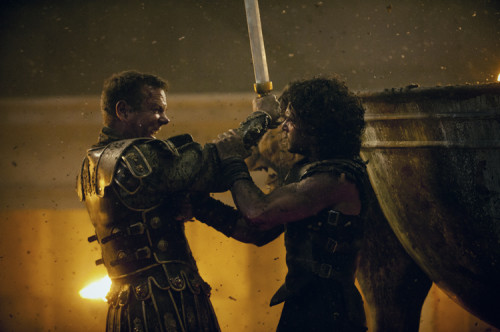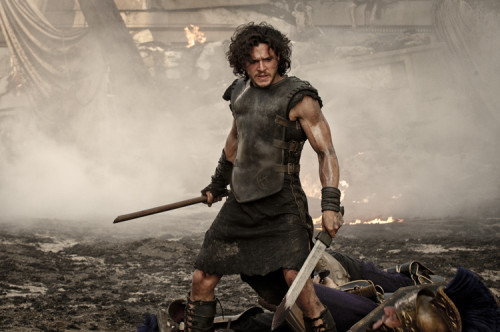Pompeii, Paul W.S. Anderson’s new movie comes out this week and is a disaster movie based on a true life historical event. Here are 15 things you might not know about the historic volcano that destroyed the city of Pompeii.
1) As depicted in Paul Anderson’s POMPEII, on August 24, 79 AD, Mount Vesuvius erupted, spewing a column of ash and pumice high into the atmosphere around the volcano at the rate of 1.5 million tons per second. The column rose 21 miles high, and was carried toward the cities of Pompeii and Herculaneum by strong easterly winds. Within hours, the cities were buried in ash and the volcanic cloud blocked out the sun completely, leaving the area in complete darkness. For terrified inhabitants it was about to get worse as a series of six devastating pyroclastic surges wreaked devastation beyond comprehension obliterating and burying Pompeii and Herculaneum.
2) The deadly pyroclastic surges that struck Pompeii are known as “glowing avalanches” of hot ash wiping out everything in its path and laying waste to the city before the population had time to flee.
3) Recent excavations have found hundreds of bodies preserved in the volcanic material, with fear and desperation twisted on their faces for eternity. Nobody knows the exact number of people killed by the eruption of Vesuvius, but is believed to be in the thousands.
4) As studied and measured by geophysicists, and as depicted in Paul Anderson’s POMPEII, the energy emitted by the explosion in 79 AD from Mt. Vesuvius was 100,000 times the thermal energy released by the Hiroshima bombing. Most of Pompeii’s victims died instantly and were flash-heated to death. Any survivors would have been burned and asphyxiated to death.
5) As depicted in Paul Anderon’s POMPEII, the eruption of Mt. Vesuvius in 79 AD was so powerful that the top of Vesuvius fell by 2000 feet with the effects compared to a nuclear blast! The eruption so intense that it filled in new shoreline moving Pompeii more inland.
6) Pyroclastic flows, such as those experienced from Mt. Vesuvius by Pompeian’s in 79 AD, can move as fast as 450 mph with temperatures as high as 1,830 degrees F, exterminating everything in its path and making it impossible to escape.
7) Often overlooked by educators, historians and media, the 79 AD eruption of Mt. Vesuvius created a tsunami in the Bay of Naples.
8) As depicted in Paul Anderson’s POMPEII, Mt. Vesuvius is a stratovolcano. Most rocks that erupt from Vesuvius are andesite, which creates explosive eruptions making Vesuvius especially dangerous and unpredictable, even today.
9) There is only one type of volcano more threatening to humanity than Mt. Vesuvius, it is the super-volcano. A super-volcano that erupted 250 million years ago is now believed to have created the greatest mass extinction the world has ever seen, wiping out up to 95 percent of all plant and animal species. Some scientists believe it was a volcano, not an asteroid, that killed off the dinosaurs 65 millions years ago.
10) Could the United States become the next Pompeii? The second most cataclysmic event for Earth outside a asteroid strike would be a super-volcanic eruption. Super-volcanoes are hundreds of times more powerful than conventional volcanoes — with the potential to wipe out civilization as we know it. One of the world’s largest super-volcanoes sits beneath Yellowstone National Park in the United States. An analysis of the molten rock within the dormant super-volcano has revealed that a super eruption is possible without any external trigger or warning, scientists say. If such an eruption should happen at Yellowstone, two-thirds of the U.S would become uninhabitable as toxic air sweeps through it, grounding thousands of flights, choking communication networks and forcing millions to leave their homes. The Yellowstone super-volcano has been rising at a record rate since 2004, which is of some concern to scientists.
11) Today, geologists and volcanologists who study Mt. Vesuvius concede that the volcano is overdue for an explosion. The Vesuvius Observatory monitors seismic activity, gas emissions and other indicators 24 hours a day to know at the earliest point when it may erupt. It would be more deadly today as the Bay of Naples has a current population of 3 million people.
12) As depicted in Paul Anderson’s POMPEII, the slaves who fought as gladiators were from a diverse set of cultures and races. This is an accurate portrayal of slavery under Roman law, which had nothing to do with one’s race, only with which country or rebellion the Romans had subdued. Slaves came from Britannia to Africa, and from all over the Empire. Even in hard economic times, it would not be uncommon for desperate Roman citizens to raise money by selling their own children into slavery.
13) Prior to production of Pompeii, the filmmakers Paul Anderson, Jeremy Bolt and team, spent six years researching Pompeii. They imaged every street and building in the city and the surrounding area so that the film would portray this magnificent civilization as accurately as possible. The team conducted extensive flyovers of Mt. Vesuvius, as well as active volcanoes, so that the imagery in the film would be as visually accurate as possible.
14) The lifestyle of the wealthy Pompeian’s was one of opulence and unparalleled luxury, even by today’s standards. Their diet consisted of a wealth of fish, nuts, grains, olives, fruits, and according to recent excavations, may have included giraffe and flamingoes as Pompeian restaurants had a long-distance business of trade in exotic and wild animals.
15) Mt. Vesuvius is a super power of the natural world, today it stands as threatening as ever. The next eruption would be devastating and the next eruption is expected to be an enormous cataclysmic explosion and possibly worse than that of 79 AD. It could change the climate of all of Europe and might make it impossible to evacuate the 3 million residents currently living in close proximity to it at the Bay of Naples.









